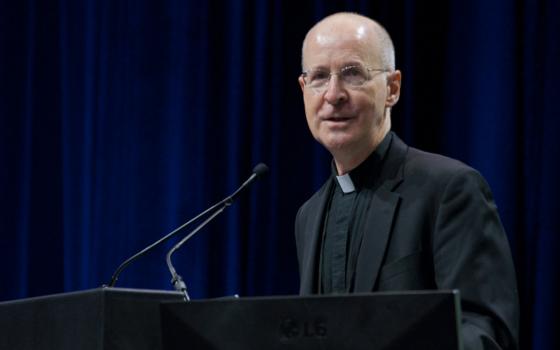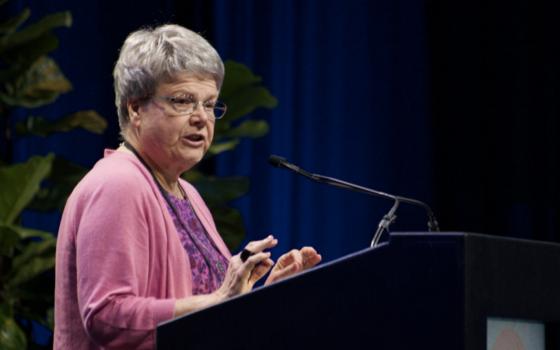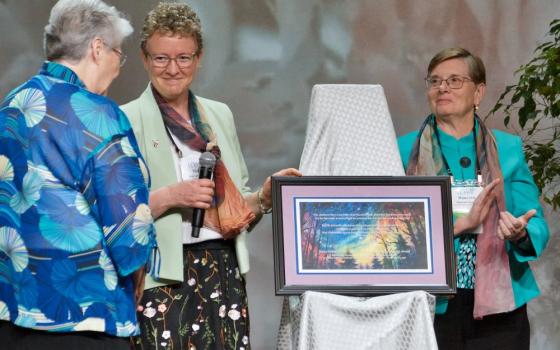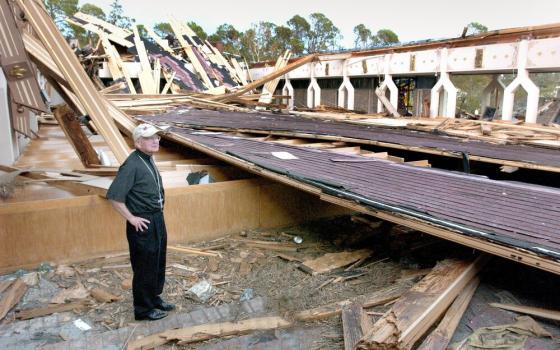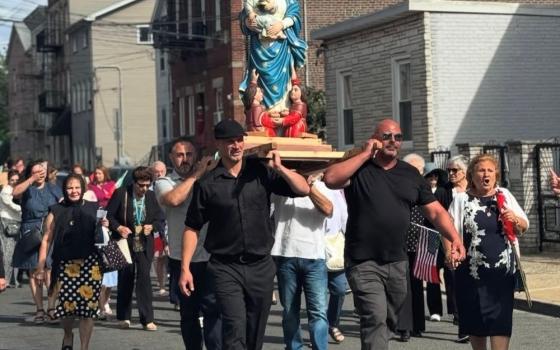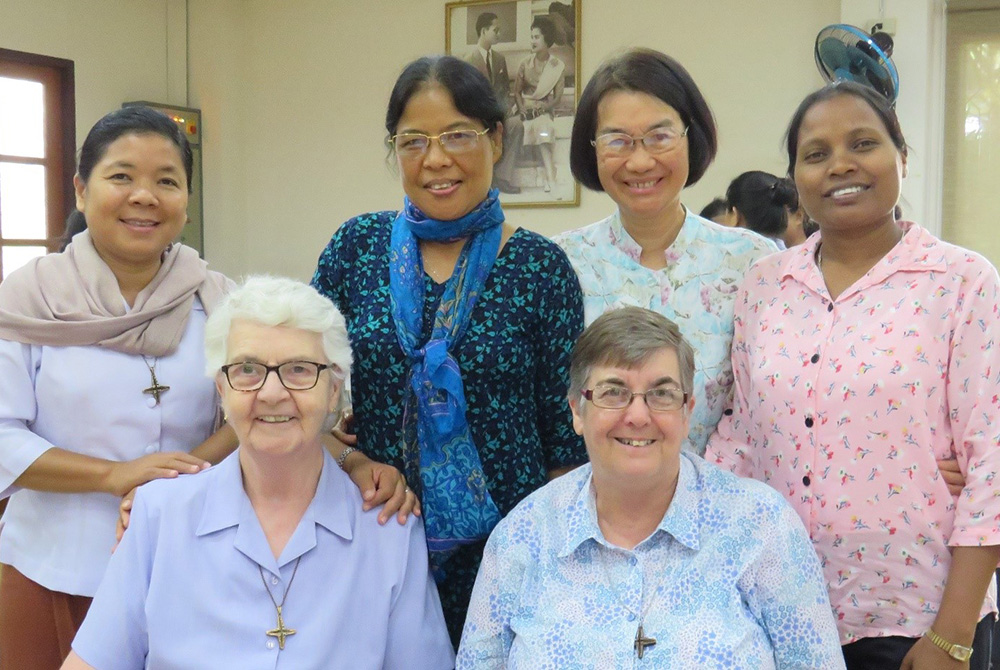
A representative group of the 2020 congregation chapter members of the Sisters of Our Lady of the Missions is pictured. From left to right, back row first: Rita Phyo, Myanmar; Molina Ritchil, Bangladesh, Pham Kim Phung, Vietnam; Anita Dungdung, India; Margo Murphy, Scotland; and Jo Kane, congregation leader, New Zealand. (Courtesy of Susan Smith)
In 1961 I made my first profession as a Sister of Our Lady of the Missions, according to the constitutions written by our founder, Frenchwoman Euphrasie Barbier, and approved by the Vatican in 1877. Memorizing relevant sections of the constitutions was an integral part of our preparation for first profession, but sadly our constitutions — like those of most other 19th century foundations — were juridical, rather than theological or spiritual or visionary.
Euphrasie herself wanted her constitutions to be much more than rules and regulations that ensured conformity to canon law. She recognized that the constitutions would be key in ensuring a spirit of unity among her community, who — by the time of the Second Vatican Council, almost 100 years later — had been living and working in Europe, New Zealand, Australia, Samoa, India, Bangladesh, Myanmar, Vietnam and Canada.
Vatican II (1962-1965) was to usher in significant changes. As required by the council, in 1969 our community had an extraordinary general chapter that was mandated to produce constitutions that would guide the sisters on how to live their vocations in the latter half of the 20th century. At that chapter, five of the 41 members were Asian-born.
The interim constitutions from this chapter were replaced by what were supposed to be the definitive constitutions approved at the 1978 general chapter, and at which 6 of the 38 delegates were Asian-born. By the time of our 2020 general chapter, 32 members were Asian-born, four members were from Kenya, two from Peru, and 17 were European-born, or of European ancestry.
Such demographic shifts had been recognized as game-changing by the 2008 general chapter, when members asked for constitutions that signified that we were living in a rapidly changing world. Although neither our 2008 nor 2014 general chapter directives explicitly linked the writing of new constitutions with the congregation's changing demographics, it was generally assumed that this was a significant factor in discerning the need for such rewriting.
It was our former congregational leader, Maureen McBride (tragically killed in a traffic accident in November 2016) who had hoped to alert the wider congregation to the significance of its rapidly changing demographic and ethnic realities. When her 12 years as congregational leader finished in 2014, Maureen began to analyze the input from the different provinces that the authors of the constitutions had turned to in their work.
Maureen was fascinated by how congregational life was evolving, given the changing demographics of the congregation. The five "old, western" provinces — France, New Zealand, United Kingdom and Ireland, Australia and Canada — were no longer numerically strong. Numbers there had dropped significantly since Vatican II. For example, on the eve of Vatican II, there were almost 250 Sisters of Our Lady of the Missions in New Zealand, and today in our province, we are currently just under 80. The reverse situation was occurring in Asian provinces of the congregation where today 67% of the congregation live and work.
For Maureen, the changing cultural and ethnic diversity of the congregation was something that needed researching and analyzing. It was agreed that Maureen should devote more time to a study of the implication of changing congregational demographic and geographical realities. Her study would involve the analysis and critique of the considerable documentation that the committee charged with rewriting the constitutions had received from our sisters throughout the world.
Maureen's sudden death precluded her completing this important work, a task that I undertook. Let me briefly concentrate on two dimensions of our religious life that direct attention to different cultural specificities in the congregation, and to see whether or not these impacted the approved version of the 2014 constitutions.
Advertisement
First, in reading the reports from some Asian provinces where the median ages were approximately 45, I noted some concern about the large number of sisters in temporary profession having active voting rights. In provinces such as New Zealand, where the median age was 81, there were no such concerns. In the constitutions written by Euphrasie, sisters in temporary vows had active voting rights, but not passive. ("Active" vote means all sisters who have made their first profession can vote, while "passive" vote means that those sisters who have not made their final profession, cannot be voted for for particular offices or responsibilities in the congregation.) Such culturally specific realities — as suggested by some — did not find their way into the 2014 constitutions.
The second point, which also implicitly directed attention to differing cultural mores, emerged in reports as to what community life required of our sisters. African, Asian and Latin American provinces as well as canon law believe that community life required physical togetherness under one roof, while Western provinces believed that emerging ministerial and personal requirements meant that "living singly" was an appropriate option for the contemporary sister.
Again, what was acceptable in one culture such as New Zealand society, where over 10% of the country's population lives alone – and this is particularly true of older people – was not acceptable in other cultures. Almost without exception, other provinces commented that living singly was an expensive option, it was not compatible with canonical requirements and it was culturally inappropriate. The authors of the constitutions opted for nuanced and diplomatic language in the articles on community in the constitutions.
Changing cultural realities can be both challenging and life-giving for an international missionary congregation. Prior to Vatican II, uniformity among our different provinces and an often-rigid adherence to rules around habit, lifestyle or prayer life were the norm. After the Second Vatican Council, that uniformity began to disappear, rapidly in Western provinces and more hesitantly in other provinces, and instead we moved towards the language of "unity in diversity."
I am not certain how "unity in diversity" can be explicitly honored in constitutions. Our constitutions have to speak to me, a senior sister in New Zealand, as well as to a young sister in Vietnam or Senegal. Perhaps these challenges can be met by different provinces having their own directories or handbooks that can and should be culturally specific so long as they confirm to the constitutions which are more generalized.
Today's constitutions are more informed by theology than canon law, more aspirational and spiritual than juridical. How they should be lived becomes the responsibility of a particular province, with oversight provided by congregation chapters and leadership. In this way, "unity in diversity" can be honored.

